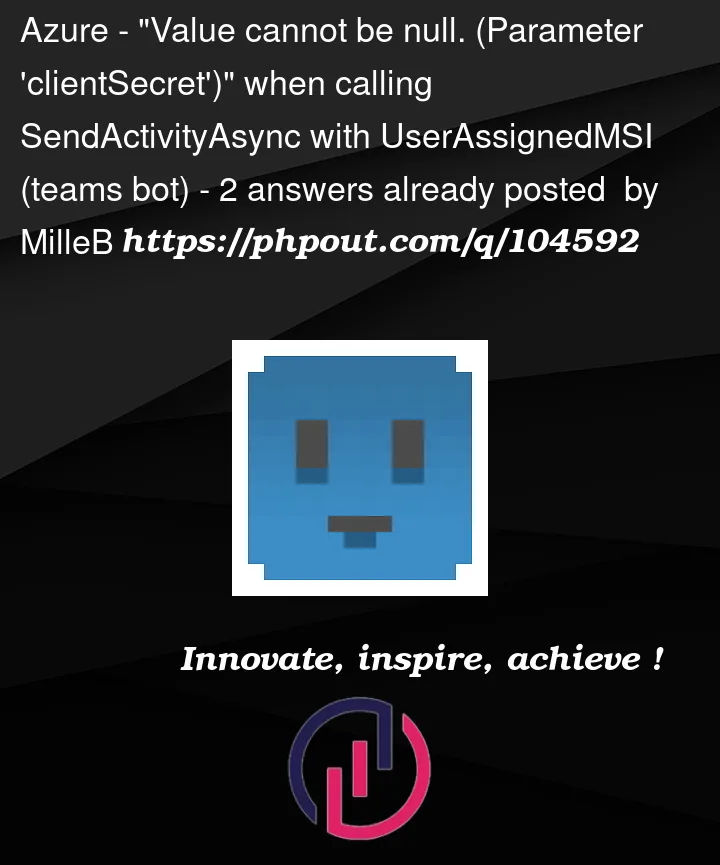I’m currently trying to set up a new teams bot but can’t really get it to work.
I have created a new Azure Bot service in azure, set it to UserAssignedMSI and I have managed to add it to teams. If I send something to the bot I can also see that the methods like OnTurnAsync and OnMessageActivityAsync are triggered so everything looks good so far.
But the moment I try to send something back, like for example:
protected override async Task OnMessageActivityAsync(ITurnContext<IMessageActivity> turnContext, CancellationToken cancellationToken)
{
await turnContext.SendActivityAsync(MessageFactory.Text("hello"), cancellationToken);
await base.OnMessageActivityAsync(turnContext, cancellationToken);
}
It crash with the following:
System.ArgumentNullException: Value cannot be null. (Parameter 'clientSecret')
at Microsoft.IdentityModel.Clients.ActiveDirectory.ClientCredential..ctor(String clientId, String clientSecret)
at Microsoft.Bot.Connector.Authentication.MicrosoftAppCredentials.<BuildAuthenticator>b__16_0()
at System.Lazy`1.ViaFactory(LazyThreadSafetyMode mode)
at System.Lazy`1.ExecutionAndPublication(LazyHelper executionAndPublication, Boolean useDefaultConstructor)
at System.Lazy`1.CreateValue()
at System.Lazy`1.get_Value()
at Microsoft.Bot.Connector.Authentication.AppCredentials.<BuildIAuthenticator>b__36_0()
at System.Lazy`1.ViaFactory(LazyThreadSafetyMode mode)
at System.Lazy`1.ExecutionAndPublication(LazyHelper executionAndPublication, Boolean useDefaultConstructor)
at System.Lazy`1.CreateValue()
at System.Lazy`1.get_Value()
at Microsoft.Bot.Connector.Authentication.AppCredentials.GetTokenAsync(Boolean forceRefresh)
at Microsoft.Bot.Connector.Authentication.AppCredentials.ProcessHttpRequestAsync(HttpRequestMessage request, CancellationToken cancellationToken)
at Microsoft.Bot.Connector.Conversations.ReplyToActivityWithHttpMessagesAsync(String conversationId, String activityId, Activity activity, Dictionary`2 customHeaders, CancellationToken cancellationToken)
at Microsoft.Bot.Connector.ConversationsExtensions.ReplyToActivityAsync(IConversations operations, String conversationId, String activityId, Activity activity, CancellationToken cancellationToken)
at Microsoft.Bot.Builder.BotFrameworkAdapter.SendActivitiesAsync(ITurnContext turnContext, Activity[] activities, CancellationToken cancellationToken)
at Microsoft.Bot.Builder.TurnContext.<>c__DisplayClass31_0.<<SendActivitiesAsync>g__SendActivitiesThroughAdapter|1>d.MoveNext()
--- End of stack trace from previous location ---
at Microsoft.Bot.Builder.TurnContext.SendActivityAsync(IActivity activity, CancellationToken cancellationToken)
at iPMC.Autotest.DevOps.Bots.Bots.AutotestBot.OnMessageActivityAsync(ITurnContext`1 turnContext, CancellationToken cancellationToken)
And I’m note sure why. According to the documentation this should be enough in my appsettings.json when using user assigned identity (AVALUE is of course my real values):
"MicrosoftAppType": "UserAssignedMSI",
"MicrosoftAppId": "AVALUE",
"MicrosoftAppTenantId": "AVALUE",
"MicrosoftAppPassword": "",
"ConnectionName": "AVALUE"
It’s seems like most examples use password as well so I can’t really find anyone else that have used this.
I have also tried to both do it locally and deployed but I get the same exception on both places so I’m running out of ideas what I should test next.
Anyone else that have used UserAssignedMSI with teams bots and got it to work?




2
Answers
You need to generate a client secret and store it in your
appsettings.jsonfile.The documentation on deploying bots here covers MSI bots, and it appears to be up-to-date. I was able to deploy a simple MSI bot to Azure following these steps.
You need to ensure that certain things align. The AppId in your bot should be your Managed Identity’s ClientId, and your Managed Identity needs to be assigned to the bot correctly. When you deploy using the ARM templates the documentation refers to, these details are handled for you.